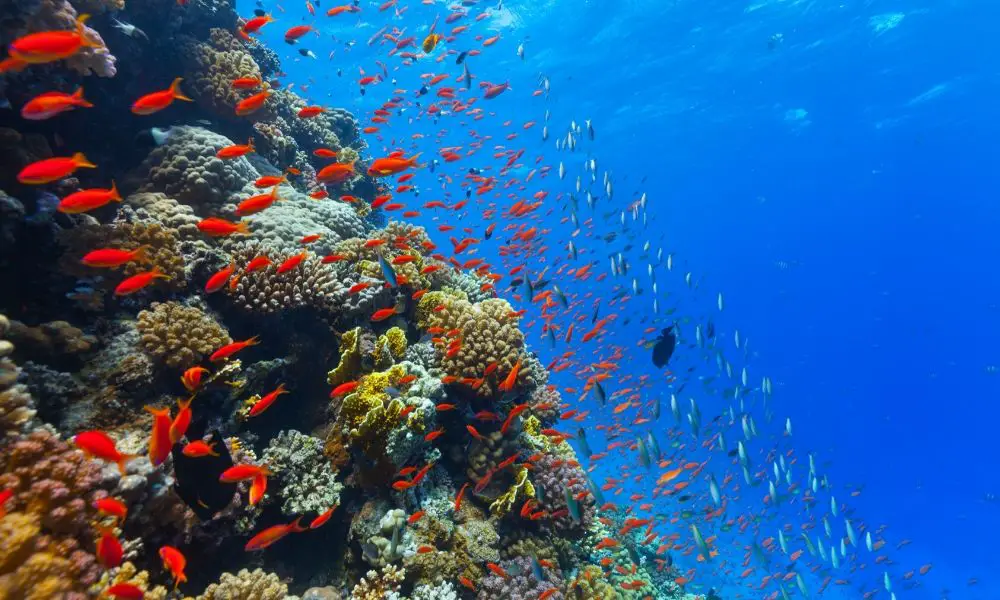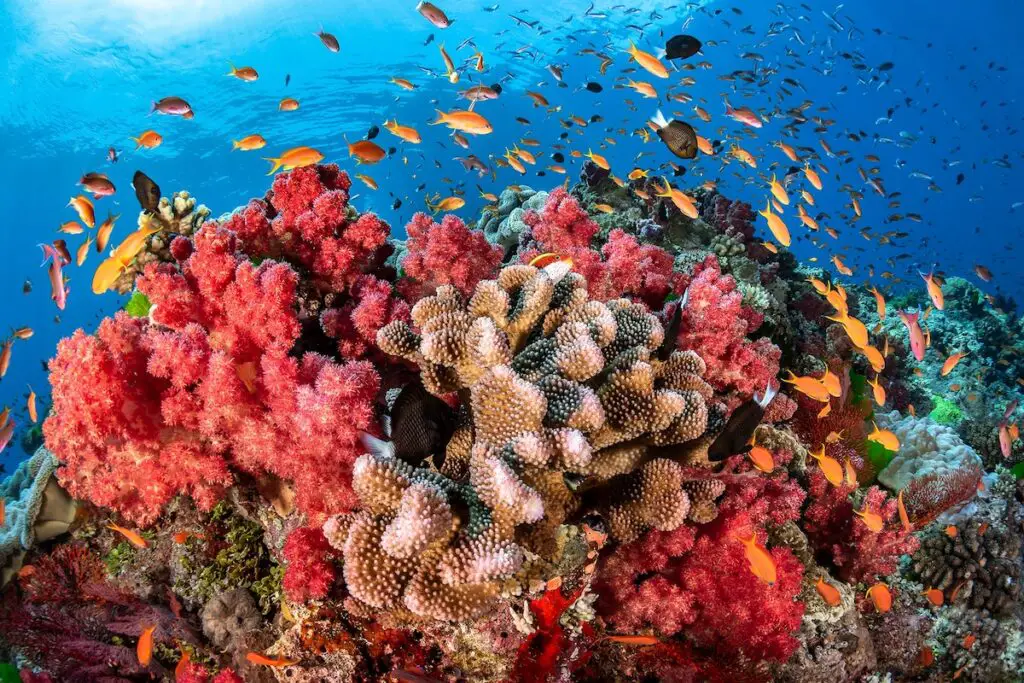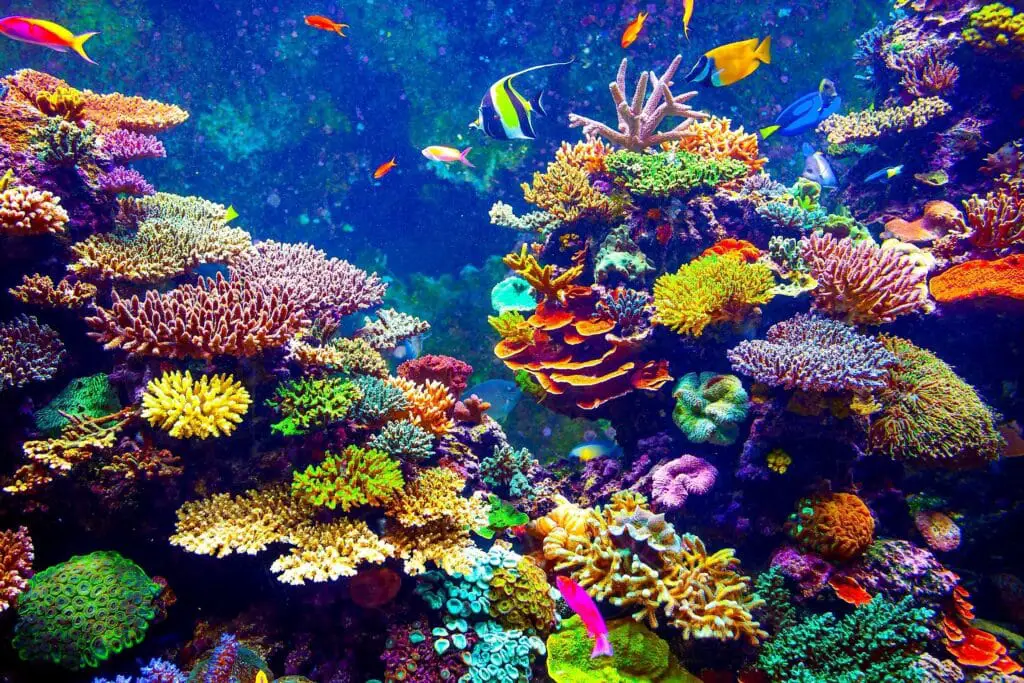How Do Coral Reefs Grow

Introduction
How Do Coral Reefs Grow: Coral reefs, often referred to as the “rainforests of the sea,” are among the most diverse and ecologically significant ecosystems on our planet. These underwater wonderlands provide a habitat for a remarkable array of marine life, from vibrant fish to enigmatic sea creatures. However, the fascinating question of how coral reefs grow lies at the heart of their existence.
Coral reefs are not static structures but dynamic living entities that are in a constant state of flux. At their core are coral polyps, tiny organisms that belong to the class Cnidaria. These minuscule creatures are responsible for the intricate and gradual construction of coral reefs over time.
The growth of coral reefs is a remarkable and intricate process. It begins with individual coral polyps secreting a calcium carbonate exoskeleton, forming a hard, protective structure around themselves. As these polyps multiply and continue to secrete calcium carbonate, they build upon each other’s skeletons, creating the foundation of the reef. Over time, this process, known as calcification, results in the impressive, intricate structures that we associate with coral reefs.
But coral reefs are not just products of coral growth; they are also shaped by environmental factors such as water temperature, light, and water quality. These factors influence the health and resilience of coral reefs, making them susceptible to various threats, including climate change and human activities.

What do coral reefs need to grow?
Most reef-building corals also require very saline (salty) water ranging from 32 to 42 parts per thousand. The water must also be clear so that a maximum amount of light penetrates it. This is because most reef-building corals contain photosynthetic algae, called zooxanthellae, which live in their tissues.
Coral reefs, often referred to as the “rainforests of the sea,” are complex and fragile ecosystems that require specific conditions to thrive and grow. Several key factors are essential for the development and sustenance of coral reefs.
- Sunlight: Coral reefs are typically found in shallow, clear waters where sunlight can penetrate. Sunlight is vital for the photosynthetic processes of the symbiotic algae, called zooxanthellae, that live within the coral polyps.
- Warm Water: Coral reefs thrive in warm tropical waters with temperatures between 73°F and 84°F (23°C to 29°C). They are particularly sensitive to temperature fluctuations and can experience coral bleaching if water temperatures rise beyond their tolerance levels.
- Clear Water: Corals need clear water to allow sufficient light penetration. Sedimentation, pollution, and excessive nutrients can block sunlight and harm coral health.
- Stable Salinity: Fluctuations in salinity can stress corals. Stability in salt levels is crucial for their well-being.
- Low Pollution: Coral reefs are highly sensitive to pollution from runoff, sewage, and chemicals. Pollution can disrupt the delicate balance of the ecosystem and harm coral health.
Preserving these conditions is essential for the growth and survival of coral reefs, as they are currently threatened by climate change, ocean acidification, and huma
Where do coral reefs grow?
The majority of reef building corals are found within tropical and subtropical waters. These typically occur between 30o north and 30o south latitudes. The red dots on this map show the location of major stony coral reefs of the world.
Coral reefs are found in various locations around the world, primarily in warm, tropical and subtropical waters. They thrive in specific environmental conditions, and their distribution is influenced by factors such as water temperature, depth, and clarity. Here are some of the key regions where coral reefs grow:
- Tropical Oceans: The largest and most well-known coral reef systems are found in the tropical oceans of the world, particularly in the Western Pacific, the Indian Ocean, and the Caribbean Sea.
- Shallow Coastal Areas: Coral reefs predominantly grow in shallow coastal areas, typically at depths ranging from a few feet to about 100 feet (1 to 30 meters).
- Clear Water: Coral reefs require clear, nutrient-poor water to thrive. This clarity enables sunlight to reach the corals and supports the growth of the symbiotic algae. Areas with reduced sedimentation and low levels of pollution are more conducive to healthy reef development.
- Islands and Continental Shelves: Coral reefs often encircle islands and occur along continental shelves, where the ocean floor gradually slopes into deeper waters.
- Coral Atolls: Some of the most iconic coral reef formations are found in coral atolls, which are ring-shaped coral islands or reefs that encircle lagoons. The Maldives and the Great Barrier Reef in Australia are famous examples.
The distribution of coral reefs is influenced by their specific ecological requirements and the geographical features of the surrounding areas. Sadly, many coral reefs are under threat due to factors such as climate change, ocean acidification, and human activities, emphasizing the importance of conservation efforts to protect these vital ecosystems.
How does coral grow and survive?
The coral polyps (animals) provide the algae (plants) a home, and in exchange the algae provide the polyps with food they generate through photosynthesis. Because photosynthesis requires sunlight, most reef-building corals live in clear, shallow waters that are penetrated by sunlight.
Coral growth and survival are remarkable processes driven by intricate ecological interactions. Corals are not just individual organisms; they are colonies of tiny polyps, and they rely on specific conditions to thrive and persist.
- Polyp Formation: Corals start as tiny larvae that settle on a suitable substrate on the ocean floor. These larvae then develop into polyps, which are the building blocks of coral colonies.
- Symbiotic Relationship: Corals have a symbiotic relationship with photosynthetic algae called zooxanthellae. These algae live inside the coral polyps and provide them with essential nutrients through photosynthesis, including sugars and oxygen. In return, the coral polyps offer protection and access to sunlight.
- Calcium Carbonate Exoskeleton: Corals secrete a hard exoskeleton made of calcium carbonate. Over time, as polyps grow and divide, this exoskeleton expands, forming the intricate structures we associate with coral reefs. This process requires calcium ions and bicarbonate ions, which are obtained from seawater.
- Optimal Conditions: Corals thrive in warm, clear, and nutrient-poor waters. Adequate sunlight is crucial for photosynthesis, but not too much, as excessive heat can lead to coral bleaching. Stable salinity levels and low pollution are also essential.
Corals’ ability to grow and survive is a delicate dance between environmental factors, biological processes, and ecological relationships. Unfortunately, these ecosystems are facing unprecedented threats, including climate change, ocean acidification, and habitat destruction, making conservation efforts critical to their continued existence.
Where do corals grow and why?
The corals’ requirement for high light also explains why most reef-building species are restricted to the euphotic zone, the region in the ocean where light penetrates to a depth of approximately 70 meters. The majority of reef-building corals are found in tropical and subtropical waters.
Corals, often referred to as the “rainforests of the sea,” primarily grow in shallow, warm, and nutrient-rich tropical and subtropical waters around the world. They are most commonly found in the following regions:
- Coral Reefs: The majority of corals grow in coral reefs, which are typically located in the clear, sunlit waters of the Indo-Pacific Ocean, the Caribbean Sea, and the Red Sea. These areas offer the ideal conditions for coral growth, including warm water temperatures between 20°C and 30°C (68°F to 86°F) and ample sunlight for photosynthesis.
- Shallow Coastal Areas: Corals can also be found in shallow coastal areas, including lagoons, bays, and inlets.
- Submerged Platforms and Atolls: Some corals grow on submerged platforms and atolls. These formations are often the result of ancient volcanic activity.
Corals thrive in these locations due to their unique relationship with symbiotic algae called zooxanthellae. The warm, clear waters in coral habitats are optimal for both coral growth and the photosynthetic activity of zooxanthellae.
What are 3 conditions for coral reef growth?
Clear water: Corals need clear water that lets sunlight through. Warm water temperature: Corals generally live in water temperatures of 68–90° F or 20–32° C. They have tolerance to a very narrow temperature range. Clean water: Corals are sensitive to pollution and sediments.
Coral reefs, vibrant and diverse marine ecosystems, require specific conditions for their growth and maintenance. Three critical conditions for coral reef growth are:
- Warm Water Temperatures: Coral reefs thrive in warm waters typically ranging from 20°C to 30°C (68°F to 86°F). These temperatures are essential for the metabolic processes of the coral polyps and the symbiotic algae (zooxanthellae) that live within them.
- Clear, Sunlit Waters: Coral reefs are usually found in shallow, clear waters where sunlight can penetrate to support photosynthesis. Sunlight is the primary energy source for the zooxanthellae.
- Stable and Saline Environment: Coral reefs require stable environmental conditions, including consistent salinity levels. Fluctuations in salinity can stress coral polyps and hinder their ability to calcify and build their calcium carbonate skeletons.
These conditions are interdependent, and any disruption, such as increased sea temperatures due to climate change or pollution, can lead to coral bleaching and, ultimately, the decline of coral reefs.
What makes coral grow faster?
Keeping proper and stable levels of light, food, nutrients, elements and water flow is the key to maximizing both coral growth and color in a reef aquarium. Just remember, nothing good happens fast!
Coral growth rate is influenced by various factors, and understanding what makes coral grow faster is crucial for coral reef conservation efforts. One key factor is water temperature. Corals thrive in warm waters, typically between 73°F to 84°F (23°C to 29°C). Higher temperatures can accelerate their metabolic processes, leading to faster growth. However, excessively high temperatures can cause coral bleaching, a stress response that can be detrimental to their health.
Water quality plays a significant role as well. Corals require clean, nutrient-rich water with the right balance of calcium and alkalinity to build their calcium carbonate skeletons. Pollution, sedimentation, and nutrient runoff can hinder coral growth by smothering them or disrupting their delicate chemical balance.
Finally, coral growth is influenced by genetic factors, species-specific traits, and their ability to resist diseases and predators.
To promote faster coral growth, conservation efforts should focus on protecting coral habitats, mitigating climate change, and reducing pollution to create the optimal conditions for these vital marine organisms to thrive.
What are 5 importance of coral reefs?
Benefits of coral reef ecosystems
Coral reefs protect coastlines from storms and erosion, provide jobs for local communities, and offer opportunities for recreation. They are also are a source of food and new medicines. Over half a billion people depend on reefs for food, income, and protection.
Coral reefs are vital ecosystems in our oceans, providing numerous benefits that are essential for both marine life and human well-being. Here are five key importance of coral reefs:
Biodiversity Hotspots: Coral reefs are often referred to as the “rainforests of the sea” due to their incredible biodiversity. They support a vast array of marine species, providing a habitat for countless fish, invertebrates, and other organisms.
Coastal Protection: Coral reefs act as natural barriers, protecting coastlines from erosion, storm surges, and strong waves. They reduce the impact of tropical storms and hurricanes, safeguarding coastal communities and infrastructure.
Tourism and Recreation: Coral reefs are a major attraction for tourists and provide livelihoods for millions of people. Snorkeling, scuba diving, and ecotourism activities generate substantial income for local economies, promoting sustainable development in coastal regions.
Carbon Sink: Coral reefs play a crucial role in mitigating climate change. They absorb and store large amounts of carbon dioxide from the atmosphere, helping to reduce greenhouse gas levels and combat global warming.
Pharmaceutical Potential: Many coral reef species contain compounds with potential pharmaceutical applications. Research into these organisms has led to the discovery of novel drugs for treating diseases such as cancer, pain, and bacterial infections.
Why does coral grow better in warm water?
The world’s corals live on the edge. They need warm water and lots of sunlight to feed the symbiotic algae that live with them.
Coral grows better in warm water primarily due to its dependence on a delicate symbiotic relationship with photosynthetic algae called zooxanthellae. This partnership is essential for coral’s growth and survival. Here’s why warm water is favorable for coral growth:
Optimal Photosynthesis: Warm water provides the ideal temperature range (typically between 73°F to 84°F or 23°C to 29°C) for the zooxanthellae to carry out photosynthesis efficiently. Photosynthesis is the process through which these algae convert sunlight into energy, producing sugars that they share with the coral. This energy is crucial for the coral to grow and build its calcium carbonate skeleton.
Increased Metabolism: Elevated temperatures accelerate the metabolic processes of both coral and zooxanthellae. This heightened metabolic rate leads to increased growth and reproduction rates for corals, resulting in faster expansion and recovery of coral reefs.
Maintaining stable temperatures within the optimal range is essential to protect these vital marine ecosystems from the threats of climate change and coral bleaching.

Conclusion
As we’ve explored, the process of coral reef growth is not just about the accumulation of calcium carbonate skeletons; it’s about resilience, adaptation, and interconnectedness. Coral reefs are living organisms that respond to their environment, which makes them vulnerable to the increasing threats posed by climate change, pollution, and destructive human activities.
The study of how coral reefs grow underscores the urgency of preserving these invaluable ecosystems. Climate change-induced coral bleaching, ocean acidification, and habitat destruction are putting immense pressure on coral reefs worldwide. If we don’t take meaningful and immediate action to mitigate these threats.
Conservation efforts, scientific research, and responsible tourism are essential components of safeguarding coral reefs. By understanding and appreciating the intricacies of their growth, we can better appreciate the urgency of preserving these underwater marvels. In doing so, we can work towards a future where coral reefs continue to thrive, providing a home for countless marine species and reminding us of the breathtaking beauty of our planet’s oceans.



